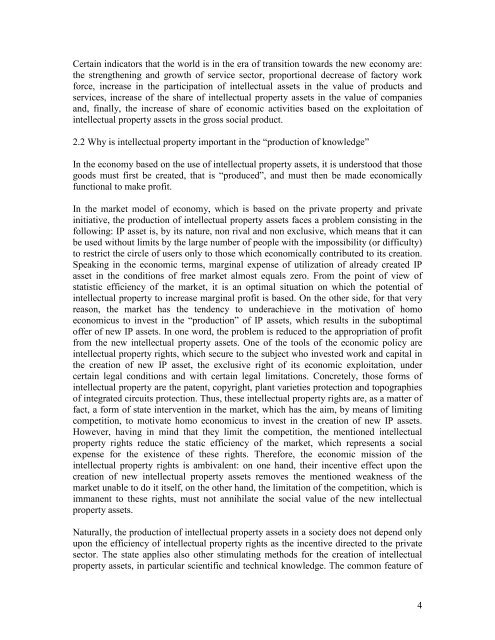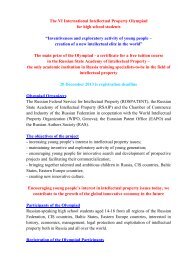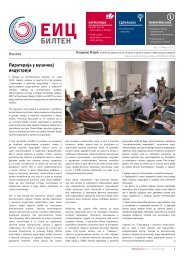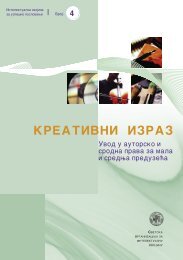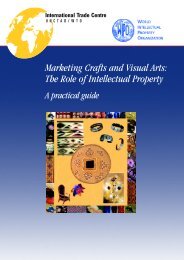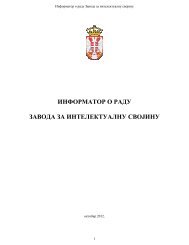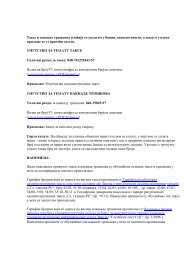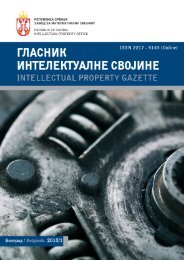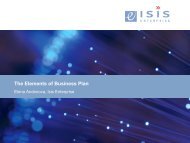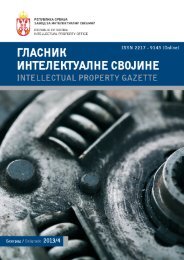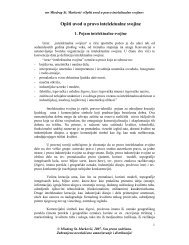Strategy of the intellectual property development for the period of ...
Strategy of the intellectual property development for the period of ...
Strategy of the intellectual property development for the period of ...
You also want an ePaper? Increase the reach of your titles
YUMPU automatically turns print PDFs into web optimized ePapers that Google loves.
Certain indicators that <strong>the</strong> world is in <strong>the</strong> era <strong>of</strong> transition towards <strong>the</strong> new economy are:<strong>the</strong> streng<strong>the</strong>ning and growth <strong>of</strong> service sector, proportional decrease <strong>of</strong> factory work<strong>for</strong>ce, increase in <strong>the</strong> participation <strong>of</strong> <strong>intellectual</strong> assets in <strong>the</strong> value <strong>of</strong> products andservices, increase <strong>of</strong> <strong>the</strong> share <strong>of</strong> <strong>intellectual</strong> <strong>property</strong> assets in <strong>the</strong> value <strong>of</strong> companiesand, finally, <strong>the</strong> increase <strong>of</strong> share <strong>of</strong> economic activities based on <strong>the</strong> exploitation <strong>of</strong><strong>intellectual</strong> <strong>property</strong> assets in <strong>the</strong> gross social product.2.2 Why is <strong>intellectual</strong> <strong>property</strong> important in <strong>the</strong> “production <strong>of</strong> knowledge”In <strong>the</strong> economy based on <strong>the</strong> use <strong>of</strong> <strong>intellectual</strong> <strong>property</strong> assets, it is understood that thosegoods must first be created, that is “produced”, and must <strong>the</strong>n be made economicallyfunctional to make pr<strong>of</strong>it.In <strong>the</strong> market model <strong>of</strong> economy, which is based on <strong>the</strong> private <strong>property</strong> and privateinitiative, <strong>the</strong> production <strong>of</strong> <strong>intellectual</strong> <strong>property</strong> assets faces a problem consisting in <strong>the</strong>following: IP asset is, by its nature, non rival and non exclusive, which means that it canbe used without limits by <strong>the</strong> large number <strong>of</strong> people with <strong>the</strong> impossibility (or difficulty)to restrict <strong>the</strong> circle <strong>of</strong> users only to those which economically contributed to its creation.Speaking in <strong>the</strong> economic terms, marginal expense <strong>of</strong> utilization <strong>of</strong> already created IPasset in <strong>the</strong> conditions <strong>of</strong> free market almost equals zero. From <strong>the</strong> point <strong>of</strong> view <strong>of</strong>statistic efficiency <strong>of</strong> <strong>the</strong> market, it is an optimal situation on which <strong>the</strong> potential <strong>of</strong><strong>intellectual</strong> <strong>property</strong> to increase marginal pr<strong>of</strong>it is based. On <strong>the</strong> o<strong>the</strong>r side, <strong>for</strong> that veryreason, <strong>the</strong> market has <strong>the</strong> tendency to underachieve in <strong>the</strong> motivation <strong>of</strong> homoeconomicus to invest in <strong>the</strong> “production” <strong>of</strong> IP assets, which results in <strong>the</strong> suboptimal<strong>of</strong>fer <strong>of</strong> new IP assets. In one word, <strong>the</strong> problem is reduced to <strong>the</strong> appropriation <strong>of</strong> pr<strong>of</strong>itfrom <strong>the</strong> new <strong>intellectual</strong> <strong>property</strong> assets. One <strong>of</strong> <strong>the</strong> tools <strong>of</strong> <strong>the</strong> economic policy are<strong>intellectual</strong> <strong>property</strong> rights, which secure to <strong>the</strong> subject who invested work and capital in<strong>the</strong> creation <strong>of</strong> new IP asset, <strong>the</strong> exclusive right <strong>of</strong> its economic exploitation, undercertain legal conditions and with certain legal limitations. Concretely, those <strong>for</strong>ms <strong>of</strong><strong>intellectual</strong> <strong>property</strong> are <strong>the</strong> patent, copyright, plant varieties protection and topographies<strong>of</strong> integrated circuits protection. Thus, <strong>the</strong>se <strong>intellectual</strong> <strong>property</strong> rights are, as a matter <strong>of</strong>fact, a <strong>for</strong>m <strong>of</strong> state intervention in <strong>the</strong> market, which has <strong>the</strong> aim, by means <strong>of</strong> limitingcompetition, to motivate homo economicus to invest in <strong>the</strong> creation <strong>of</strong> new IP assets.However, having in mind that <strong>the</strong>y limit <strong>the</strong> competition, <strong>the</strong> mentioned <strong>intellectual</strong><strong>property</strong> rights reduce <strong>the</strong> static efficiency <strong>of</strong> <strong>the</strong> market, which represents a socialexpense <strong>for</strong> <strong>the</strong> existence <strong>of</strong> <strong>the</strong>se rights. There<strong>for</strong>e, <strong>the</strong> economic mission <strong>of</strong> <strong>the</strong><strong>intellectual</strong> <strong>property</strong> rights is ambivalent: on one hand, <strong>the</strong>ir incentive effect upon <strong>the</strong>creation <strong>of</strong> new <strong>intellectual</strong> <strong>property</strong> assets removes <strong>the</strong> mentioned weakness <strong>of</strong> <strong>the</strong>market unable to do it itself, on <strong>the</strong> o<strong>the</strong>r hand, <strong>the</strong> limitation <strong>of</strong> <strong>the</strong> competition, which isimmanent to <strong>the</strong>se rights, must not annihilate <strong>the</strong> social value <strong>of</strong> <strong>the</strong> new <strong>intellectual</strong><strong>property</strong> assets.Naturally, <strong>the</strong> production <strong>of</strong> <strong>intellectual</strong> <strong>property</strong> assets in a society does not depend onlyupon <strong>the</strong> efficiency <strong>of</strong> <strong>intellectual</strong> <strong>property</strong> rights as <strong>the</strong> incentive directed to <strong>the</strong> privatesector. The state applies also o<strong>the</strong>r stimulating methods <strong>for</strong> <strong>the</strong> creation <strong>of</strong> <strong>intellectual</strong><strong>property</strong> assets, in particular scientific and technical knowledge. The common feature <strong>of</strong>4


